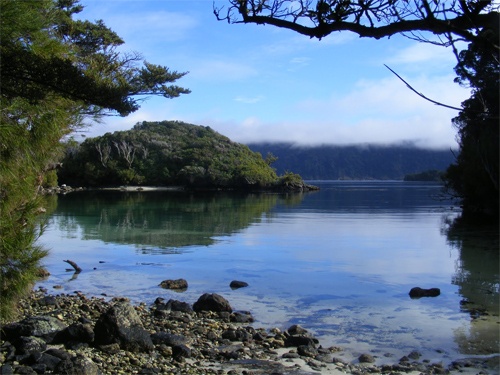
Pigeon Island Bird Pen (1894)
Cradle of conservation
‘With its superfluity of damp and sandflies, it is about the most miserable and useless place that man ever set foot in.’ Pioneer conservationist Richard Henry did not think much of his new post in Dusky Sound, where over 75 cm of rain can fall in a month in summer and the sandflies bite incessantly. Henry’s long life had a sadness to match the climate, and he ended his days in a mental hospital.
But that was far in the future in 1894, when Henry became curator and caretaker of Resolution Island. Assisted by Andrew Burt, he set up a base on neighbouring Pigeon Island, constructing a weatherboard house, hut, boatshed and bird pens at the neck of its peninsula. The men were here because of mounting concern about the fate of New Zealand’s native birds. Three years earlier the Otago Institute and the Otago Acclimatisation Society had persuaded the government to declare Resolution Island a sanctuary for flightless birds. Institute member Edward Melland helped Henry get the job. For years the former rabbiter and explorer had been warning of the danger that introduced animals posed to kākāpō, kiwi and weka.
It was rough and ready conservation. Henry used penned kiwi to control wireworm infesting his garden. He also had a thing about goats, wanting to liberate them here until he saw what they did to his beloved kākāpō’s favourite trees. Nevertheless, using trained dogs, he trapped and moved more than 800 ground birds to sanctuaries here and elsewhere in New Zealand. Although isolated, he was no hermit. In 1901 Governor Ranfurly visited him while collecting specimens for the British Museum. Visits by government steamers and the Union Company’s annual Sounds Excursion ship kept Henry in touch with the wider world. He corresponded vigorously, wrote articles for scientific publications and published The habits of the flightless birds of New Zealand (1903). In time, however, visiting yachts and fishing boats began to threaten the sanctuary’s isolation. Gentlemen shooters he could handle, mustelids he could not. In 1900 evidence of a ‘weasel’ (it was probably a stoat) signalled that, although he had proved that under the right conditions birds could survive relocation, Resolution Island’s days were numbered. In 1908 Henry moved to Kapiti Island.
The kākāpō would have to wait another 50 years before anyone would make another serious bid to save it. Richard Henry felt that he failed, but better resourced conservationists have now made New Zealand a leading player in the island sanctuaries game. In the 1990s archaeologists surveyed the scant remains of this cradle of conservation and the former Historic Places Trust gave the bird pen a Category I registration. Bottle fossickers have been pests but you can still see house and wharf piles, a stone fireplace, remains of the boatshed and slip, and, of course, the remains of the bird pen.
Further information
This site is item number 69 on the History of New Zealand in 100 Places list.
Websites
- Heritage New Zealand List
- DOC site information
- Richard Henry biography - Te Ara
- History of conservation - Te Ara
Book
-
Susanne and John Hill, Richard Henry of Resolution Island, John Mcindoe, Dunedin, 1987



Community contributions